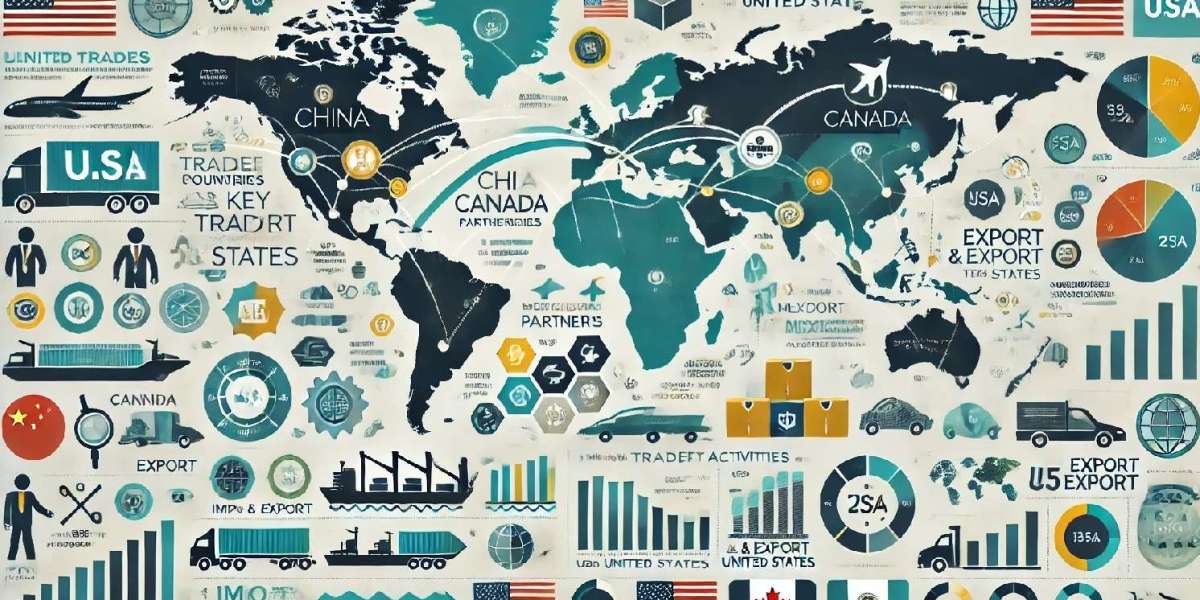The United States has long been a global leader in trade, with its diverse and dynamic export portfolio reaching markets around the world. Understanding the top exports by product category is crucial for businesses, policymakers, and trade enthusiasts to gain insight into the key drivers of the US economy. This data-driven analysis delves into the most significant export categories, backed by reliable US export data, and highlights how these exports shape the global trade landscape.
1. The Global Importance of US Exports
Exports are a cornerstone of the US economy, contributing significantly to GDP, creating jobs, and fostering international relations. In 2023, US exports were valued at over $2.5 trillion, with top export categories ranging from machinery and electronics to agricultural products and chemicals. As the US economy continues to evolve, the types of goods exported have also shifted, reflecting both domestic innovation and changing global demands.
2. Top US Exports by Product Category
To understand the most significant contributors to US exports, we need to analyze the top product categories. Here are the key sectors that have dominated US exports in recent years, with an emphasis on the role each product category plays in the economy:
a. Machinery and Electrical Equipment
Value in Exports: Machinery, including electrical machinery, computers, and telecommunications equipment, is consistently one of the largest export categories for the United States. In 2023, machinery exports were valued at over $300 billion, making it a crucial sector in global trade.
Key Products:
- Computer & Electronic Products: These include computers, semiconductors, and telecommunications equipment, which are in high demand worldwide. US manufacturers, particularly in Silicon Valley, produce some of the world’s leading technologies in computing and communication.
- Industrial Machinery: From agricultural equipment to medical devices, the US exports a wide range of industrial machinery that powers global production lines.
- Telecommunication Equipment: With advancements in 5G and high-speed internet, US companies like Qualcomm and Cisco are pivotal players in the global telecommunications landscape.
Global Demand: The global reliance on high-tech equipment makes machinery and electrical products some of the most sought-after US exports. Countries in Asia, Europe, and the Americas are major importers, driven by infrastructure development and the digital revolution.
b. Vehicles and Automotive Parts
Value in Exports: The automotive sector is another dominant player in US exports, contributing significantly to the economy. In 2023, the US exported nearly $140 billion in vehicles and automotive parts.
Key Products:
- Passenger Cars: US manufacturers, such as General Motors, Ford, and Tesla, export millions of passenger vehicles annually to countries across Europe, Canada, Mexico, and China.
- Automotive Parts and Accessories: In addition to complete vehicles, the US also exports a vast array of automotive components, including engines, transmissions, and electrical systems.
- Electric Vehicles (EVs): With the increasing shift toward sustainability, US exports of electric vehicles, particularly from companies like Tesla, have seen a dramatic rise.
Global Demand: The demand for US-made vehicles is driven by factors like quality, innovation, and consumer preference for American brands. The European Union, Canada, and Mexico remain some of the largest buyers of US automotive exports.
c. Chemicals and Pharmaceuticals
Value in Exports: The chemicals sector, including pharmaceuticals and agricultural chemicals, is a major contributor to US export value. In 2023, the export value for chemicals exceeded $150 billion, making it one of the highest-performing categories.
Key Products:
- Pharmaceuticals: The US is a global leader in the pharmaceutical industry, exporting medications and vaccines to every corner of the globe. American pharmaceutical companies such as Pfizer, Johnson & Johnson, and Merck continue to dominate global markets.
- Agricultural Chemicals: The US also exports a wide range of agricultural chemicals, including fertilizers, pesticides, and herbicides, to support food production worldwide.
- Specialty Chemicals: Products like coatings, adhesives, and plastics are in high demand across various industries, from automotive to consumer goods.
Global Demand: Countries with large healthcare needs, such as those in Europe and Asia, are key consumers of US pharmaceuticals. Similarly, agricultural chemicals are essential in regions with high agricultural production, like Latin America and Southeast Asia.
d. Aircraft and Spacecraft
Value in Exports: Aircraft and spacecraft are among the most valuable US exports, contributing over $130 billion to the economy in 2023. The US is the world’s leading producer of both commercial and military aircraft, along with cutting-edge space technology.
Key Products:
- Commercial Aircraft: US companies like Boeing and Lockheed Martin produce some of the world’s most advanced commercial airliners, which are in demand globally for both passenger and cargo transport.
- Military Aircraft: The US exports military aircraft to various countries, including fighter jets, cargo planes, and helicopters.
- Spacecraft: With the growing space industry, US exports of spacecraft, satellites, and related technology have become increasingly important.
Global Demand: Major importers of US aircraft include countries in Europe, the Middle East, and Asia. Additionally, the rising interest in space exploration and satellite technology has expanded global markets for US-made space products.
e. Agricultural Products
Value in Exports: Agricultural exports are a cornerstone of US trade, with the country being one of the largest exporters of agricultural products in the world. In 2023, the value of agricultural exports exceeded $190 billion.
Key Products:
- Soybeans: The US is one of the largest producers and exporters of soybeans, which are essential for food production, animal feed, and biofuels. Major buyers include China, Mexico, and the European Union.
- Corn: As a staple crop, corn is another major export, with the US exporting large quantities to Mexico, Japan, and South Korea.
- Meat Products: The US is a leading exporter of beef, pork, and poultry, with top markets in Asia and Latin America.
- Wheat and Rice: The US exports substantial amounts of wheat and rice, which are essential food staples worldwide.
Global Demand: The demand for US agricultural products is driven by food security concerns and growing populations in emerging economies, particularly in Asia and Africa. The US remains a key supplier for many countries looking to ensure a stable food supply.
f. Mineral Fuels and Oils
Value in Exports: The export of mineral fuels and oils, particularly crude oil and natural gas, has skyrocketed in recent years. The US is now a net exporter of oil, with export values exceeding $170 billion in 2023.
Key Products:
- Crude Oil: As the US expands its shale oil production, exports of crude oil to countries like China, Canada, and South Korea have surged.
- Natural Gas: Liquefied natural gas (LNG) exports are rising as the US capitalizes on its vast natural gas reserves, with demand growing particularly in Europe and Asia.
- Refined Petroleum Products: The US also exports a variety of refined petroleum products, including gasoline and diesel, to markets in Latin America, Europe, and Africa.
Global Demand: The demand for US energy exports is largely driven by energy-hungry countries, especially those looking to diversify their energy sources. The shift toward cleaner energy alternatives has further fueled the demand for US natural gas.
3. Conclusion: How Export Data Shapes Business Strategy
By understanding the data behind the top US exports by product category, businesses can gain invaluable insights into global trends and opportunities. Whether you are an importer, manufacturer, or policymaker, US export data provides a window into which sectors are thriving and which markets offer the most promise for future growth. The diversity of US exports—ranging from high-tech electronics to agricultural products—reflects the country’s economic resilience and capacity for innovation.
As global trade continues to evolve, keeping a close eye on export data allows businesses to make informed decisions, identify emerging opportunities, and navigate the complexities of international markets. Whether focusing on machinery, vehicles, pharmaceuticals, or agricultural products, the data reveals patterns that help companies stay competitive in an increasingly interconnected world.








